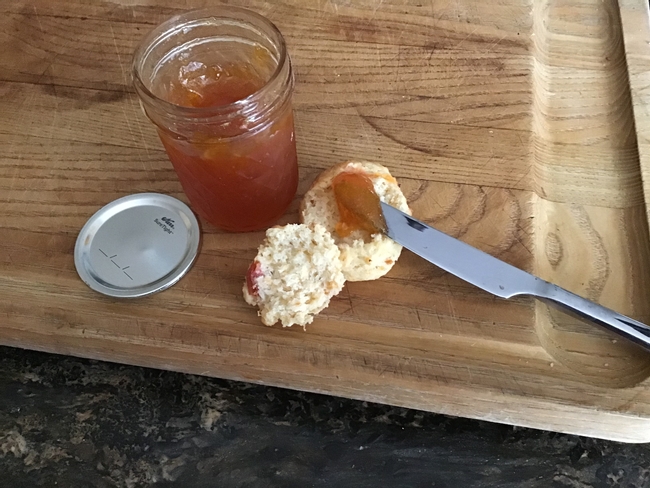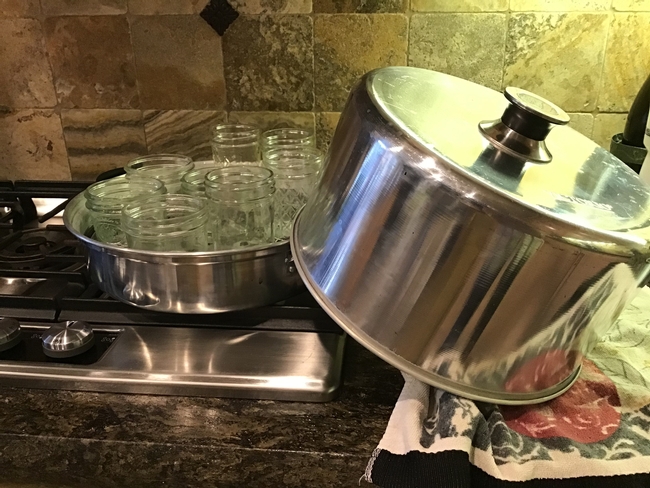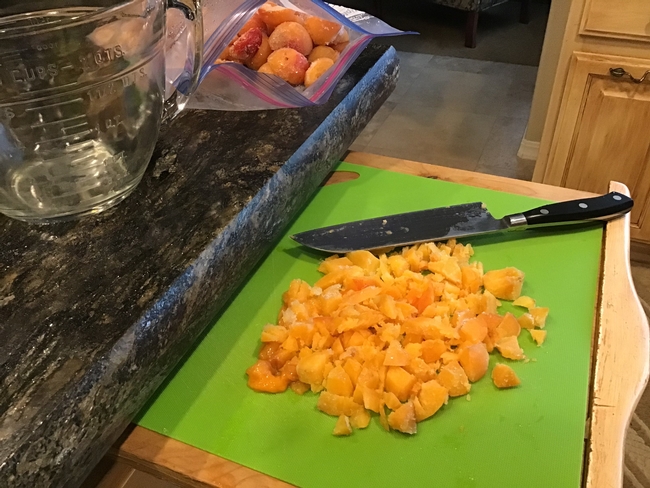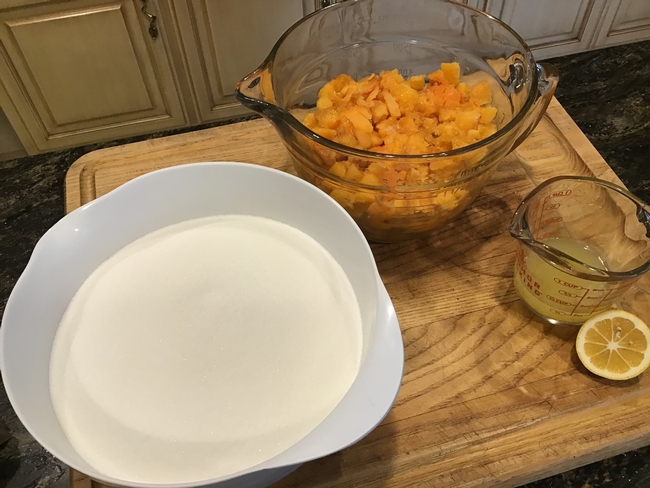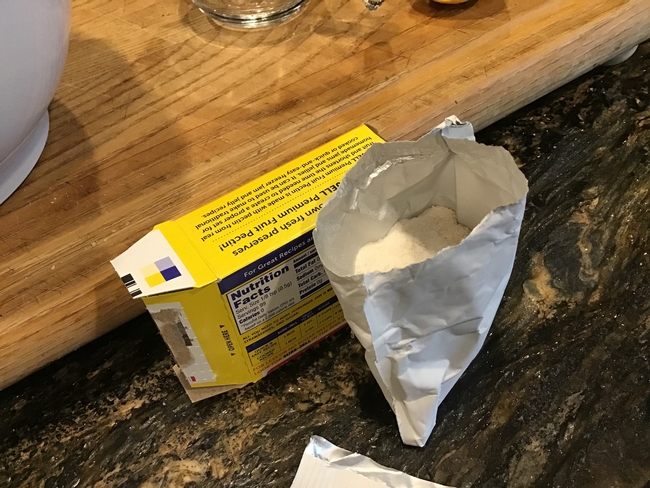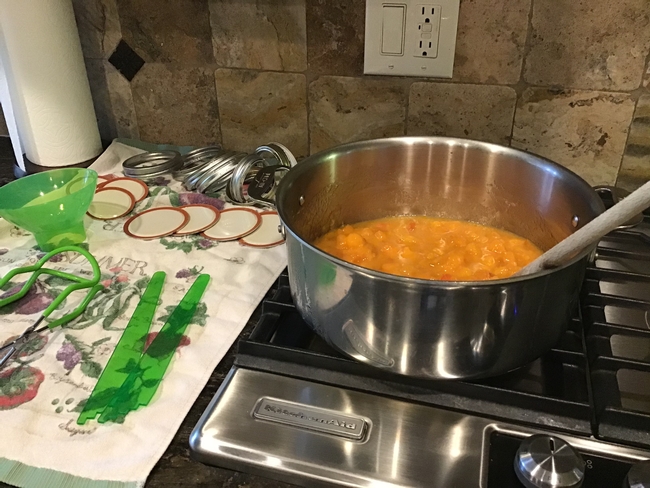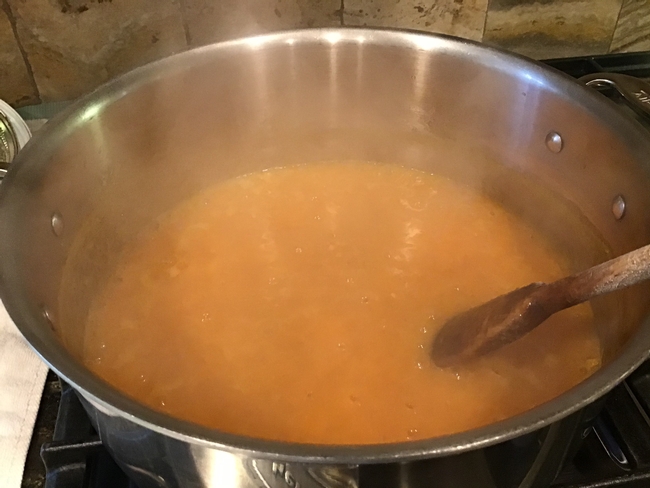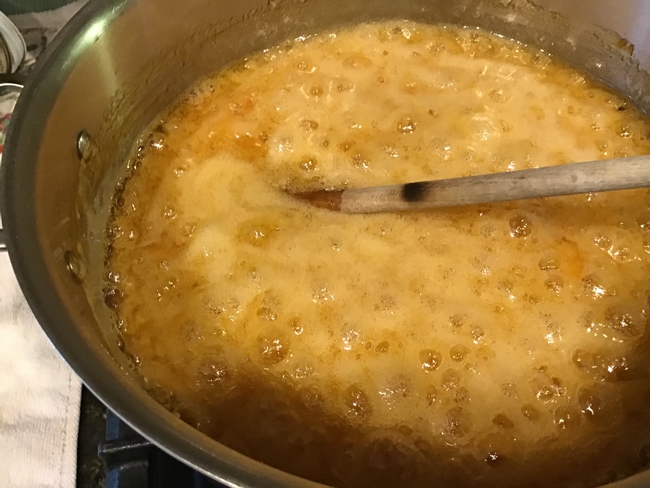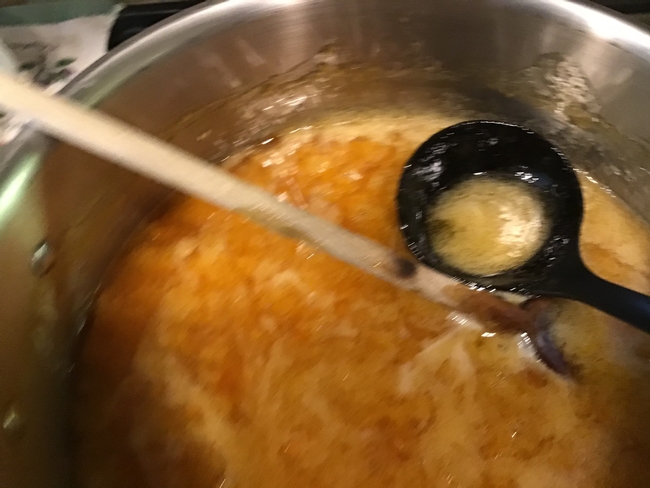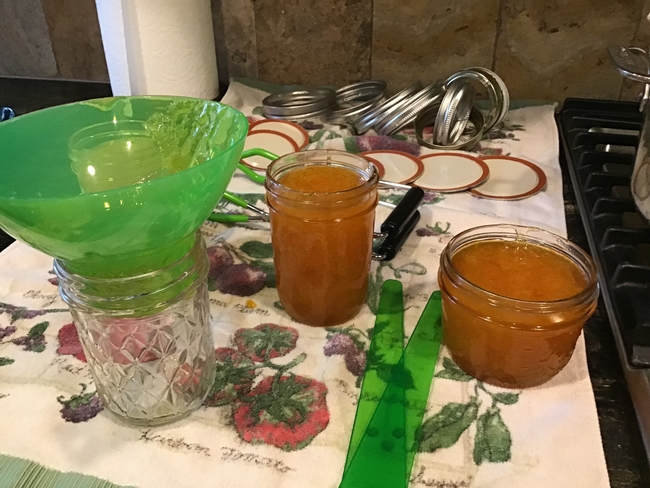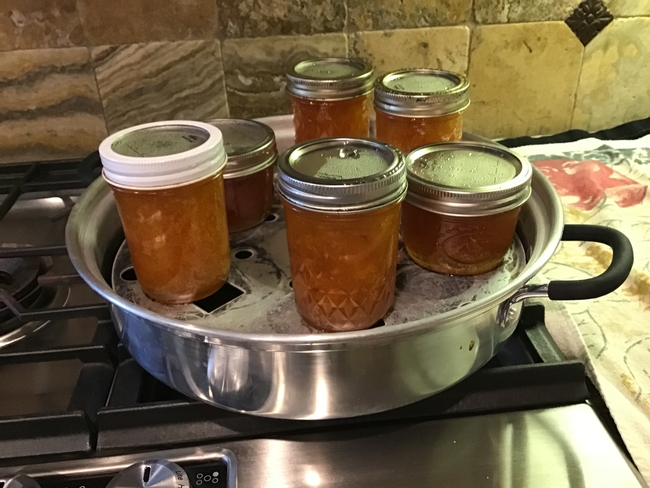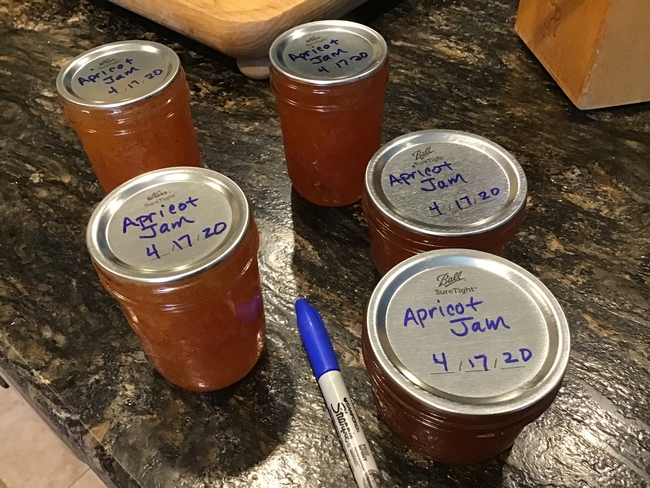I was rummaging through our upright freezer and realized I had several bags of frozen apricot halves from last summer. We have been out of jam for a while, and I thought: We need some JAM! We have frozen fruit, so let's do it! And so it begins…
Let's get started!
First, wash your hands! Using soap and water, wash your hands for at least 20 seconds and dry on a clean towel or paper towel.
Gather your supplies including equipment, ingredients, jars, etc. Make sure your preparation area is clean and free of clutter that might get in the way.
Get your jars hot. I'm using an atmospheric steam canner with this batch of jam to heat my jars as well as process them once they are filled. Steam canners are great because they use less water than a traditional boiling water canner, which also makes steam canners easier to move. But steam canners are limited by how long the recipe processing time takes. Use this piece of equipment for products that require less than 45 minutes of processing. If you don't have one of these, you can use your boiling water canner with its rack or a large stock pot tall enough to cover your jars with 1-2 inches of water with a rack.
Prepare your fruit. My fruit was frozen, so I let it partially thaw in the refrigerator (never thaw food on the counter) until the apricot halves were able to be broken apart but still had ice crystals on them.
I finely chopped the fruit as directed by the recipe from the insert in my box of pectin. It's critical to use researched and tested recipes for your home preserved foods to aid in their safety but also insure your product is what you expect.
Use a dry ingredient measuring cup to measure the fruit. Once I measured 1 cup of chopped fruit, I added it into the larger liquid measuring bowl. This is just for added insurance, so I didn't miscount! Keep chopping and measuring until you have the amount for one batch of jam. Don't double or triple recipes when making jellied products. They won't set up correctly and you'll end up with a less than desirable product. Can you say SYRUP?!!!
Now my ingredients are measured, and I'm ready to get started with the jam making! It's important to have all your ingredients prepared, pre-measured, and ready to be added according to the recipe's instructions. This will help with adding your ingredients quickly when needed. You want everything ready to go once the cooking begins. To help with obtaining a desirable gel set, it is critical you have the correct amount of sugar, lemon juice, fruit and pectin as called for in your recipe. Don't change the recipe. Follow it exactly. PECTIN? Where is the PECTIN?
Add the fruit, pectin, and lemon juice into the cooking pot. Pre-wash utensils and lids and keep them close at hand for easy access. I like to use two head-space measuring tools (the green ruler like utensils next to the pot), one for measuring the headspace and the other for de-bubbling the filled jars. This trick helps to keep my hands clean! The burner is on and the cooking begins. No sugar has been added yet. The recipe states to bring the fruit, pectin, and lemon juice to a rolling boil first.
The fruit-pectin-lemon juice mixture is just beginning to simmer. The bubbles are small and inconsistently dispersed around the top of the liquid. It will be at a full rolling boil momentarily, which is the signal to add the sugar. Constantly stir the mixture so there is no scorching or burning on the bottom of the pan. It is important to add all the sugar at once when the time comes. Continue to stir to incorporate all the sugar and prevent burning.
The sugar has been added and the boil has really taken off! This is what a rolling boil looks like, and now the timer has been set for 1 minute per the recipe's instructions. I let the mixture continue to boil for the specified time with constant stirring. You can see a foamy top layer as the jam boils. You may add ¼- ½ tsp. of butter or margarine to the fruit/pectin/lemon juice mixture to help reduce the foam production. I don't add it. I'm not bothered by the foam, and it usually seems to settle a bit once the product is jarred. But you may choose to…
…scoop it off! You can see my ladle has foam in it. I usually try to remove some of the foam, but don't throw it away! It tastes wonderful and can be used on toast, stirred into yogurt, smeared onto a graham cracker, you get the point. Once cooled, share it with the family as a prelude to the goodness that is yet to come.
Now it's time to fill the jars. Make sure your jars are hot as you fill them with the hot jam. The funnel helps to steady the fill and prevent excess spillage. Once I fill a jar, I use the rounded end of my green de-bubbler to remove any bubbles formed by moving the utensil up and down a few times around the edge of the jar and jam. You could also use a plastic butter knife or small silicone scraper to do the same thing. Just don't use any metal utensils. They could lead to jar breakage! Measure the headspace using the other end (a dedicated plastic ruler could also work) and make sure you have ¼ inch of space from the top of the jar to the top of the jam. Proper headspace is important for safety, obtaining a good seal, and preventing discoloration. Finally, wipe the rim of the jar with a damp paper towel to remove any jam along the edge. Place the lid on the clean rim and add the ring. Screw the ring on until finger-tip tight. Don't over tighten the ring!
Load the jars into your canner and process for the indicated time on your recipe. Don't start timing the process until your steam canner gauge indicator reaches the right color zone for your altitude or your water in the canner is at a boil. Time the process for the number of minutes required by the recipe according to your altitude.
Once the jars have completed the processing time, remove them carefully using a jar lifter. Lift straight up and then over to nearby towel to cool down. Don't tip or dump any water on the lid off while moving them. And don't wipe the water off the jar lids! This accumulation of hot water on the lids is part of the process. I know it's tempting, but don't touch or move the jars.
Allow your jars to cool UNTOUCHED for 12-24 hours. After this cooling time, remove the rings from your jars and check to make sure the lids have sealed. The lids should be flat and not make any noise when you press your finger on them. Also, gently grasp the lid to make sure it is secure and won't easily pop off. At this point, you may wipe them off with a damp towel to remove any sticky residue on the jar or lid. Label them with the product name and when you made it. Store these little jewels in a cool, dark space until ready to use. Keep the rings off for pantry storage. Once you open the jar, you can add the ring back on for storage in the refrigerator.
Did you have a jar not seal? It's not a problem. Just set that one in the refrigerator to be eaten first! Your sealed jars of jam will have good quality for a year if stored properly.
I've made some fresh apricot scones to enjoy my apricot jam on! Have fun! Questions or problems contact our helpline at (805) 781-1429 or email slomfp@ucanr.edu.
Apricot Jam Recipe (adapted from Sure-Jell package insert) Yield-about 9 cups
3 ½ pounds of apricots (5 cups finely chopped)
¼ cup fresh or bottled lemon juice
7 cups granulated sugar
1 (1.75oz) box of regular pectin
¼- ½ tsp. butter or margarine, optional
Instructions:
- Wash and rinse jars, lids, and rings. Set aside lids and rings and put jars into canner with simmering hot water to warm.
- Use dry measuring cup to measure exact amount of prepared fruit into a large stainless steel saucepan. Stir in lemon juice.
- Measure exact amount of sugar into a separate bowl. (DO NOT REDUCE SUGAR IN THE RECIPE SINCE THAT WILL RESULT IN SET FAILURES.)
- Stir 1 (1.75 oz.) package of regular pectin into prepared fruit. Add ½ tsp. butter or margarine to reduce foaming, if desired.
- Bring mixture to full rolling boil (a boil that doesn't stop bubbling when stirred) on high heat, stirring constantly.
- Add sugar to fruit mixture in saucepan. Return to full rolling boil; boil exactly 1 minute, stirring constantly. Remove from heat. Skim off any foam with metal spoon.
- Ladle immediately into prepared jars filling each to within ¼ inch of top. Wipe jar rims and threads. Cover with two-piece lids. Place jars on elevated rack in canner. Lower rack into canner. (Water must cover jars by 1-2 inches. Add boiling water, if needed.) Or place them on the rack in your steam canner making sure you have adequate water as described in the owner's manual. Cover; bring water to a gentle boil if using a water boiling canner, or cover your steam canner and bring the gauge to the recommended range based on your altitude then begin timing. Process jars for 10 minutes adjusting processing time as necessary for altitude. Turn off heat, remove lid and let jars set for 5 minutes. Remove jars from canner and move to a towel. Let set for 12-24 hours at room temperature. Store unopened jars in a cool, dry, dark place for up to 1 year. Refrigerate opened jam for up to 3 weeks.
